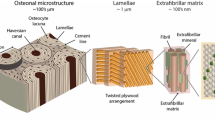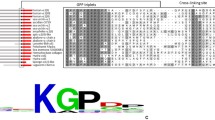Abstract
Among the vertebrate species, collagen is the most abundant protein and is associated with mineralization of their skeleton and dentition in all tissues except enamel. In such tissues, bones, calcifying tendon, dentin, and cementum are comprised principally of type I collagen, which has been proposed as a template for apatite mineral formation. Recent considerations of the interaction between type I collagen and calcium and phosphate ions as the major constituents of apatite have suggested that collagen polypeptide stereochemistry underlies binding of these ions at sites within collagen hole and overlap regions and leads to nucleation of crystals. The concept is fundamental to understanding both normal and abnormal mineralization, and it is reviewed in this article. Given this background, avenues for additional research studies in vertebrate mineralization will also be described. The latter include, for instance, how mineralization events subsequent to nucleation, that is, crystal growth and development, occur and whether they, too, are directed by collagen stereochemical parameters; whether mineralization can be expected in all spaces between collagen molecules; whether the side chains of charged amino acid residues actually point toward and into the hole and overlap collagen spaces to provide putative binding sites for calcium and phosphate ions; and what phenomena may be responsible for mineralization beyond hole and overlap zones and into extracellular tissue regions between collagen structural units. These questions will be discussed to provide a broader understanding of collagen contributions to potential mechanisms of vertebrate mineralization.



Similar content being viewed by others
References
Robinson RA (1952) An electron-microscope study of the crystalline inorganic component of bone and its relationship to the organic matrix. J Bone Joint Surg 34:389–434
Robinson RA, Watson ML (1952) Collagen-crystal relationships in bone as seen in the electron microscope. Anat Rec 114:383–410
Hodge AJ, Petruska JA (1963) Recent studies with the electron microscope on ordered aggregates of the tropocollagen macromolecule. In: Ramachandran GN (ed) Aspects of protein structure. Academic Press, New York, pp 289–300
Glimcher MJ, Krane SM (1968) The organization and structure of bone, and the mechanism of calcification. In: Ramachandran GN, Gould BS (eds) Biology of collagen. Treatise on collagen, vol IIB. Academic Press, New York, pp 68–251
Hodge AJ (1989) Molecular models illustrating the possible distribution of “holes” in simple systematically staggered arrays of type I collagen molecules in native-type fibrils. Connect Tissue Res 21:137–147
Eyre D (1987) Collagen cross-linking amino acids. Methods Enzymol 144:115–139
Yamauchi M, Katz EP, Otsubo K, Teraoka K, Mechanic GL (1989) Cross-linking and stereospecific structure of collagen in mineralized and nonmineralized skeletal tissues. Connect Tissue Res 21:159–169
Weiner S, Traub W (1986) Organization of hydroxyapatite crystals within collagen fibrils. FEBS Lett 206:262–266
McEwen BF, Song MJ, Landis WJ (1992) Quantitative determination of the mineral distribution in different collagen zones of calcifying tendon using high voltage electron microscopic tomography. J Comput Assist Microsc 3:201–210
Landis WJ, Song MJ, Leith A, McEwen L, McEwen B (1993) Mineral and organic matrix interaction in normally calcifying tendon visualized in three dimensions by high voltage electron microscopic tomography and graphic image reconstruction. J Struct Biol 110:39–54
Landis WJ, Hodgens KJ, Song MJ, Arena J, Kiyonaga S, Marko M, Owen C, McEwen BF (1996) Mineralization of collagen occurs on fibril surfaces: evidence from conventional and high voltage electron microscopy and three-dimensional imaging. J Struct Biol 117:24–35
Weiner S, Price P (1986) Disaggregation of bone into crystals. Calcif Tissue Int 39:365–375
Landis WJ, Moradian-Oldak J, Weiner S (1991) Topographic imaging of mineral and collagen in the calcifying turkey tendon. Connect Tissue Res 25:181–196
Silver FH, Landis WJ (2011) Deposition of apatite in collagenous extracellular matrices: identification of possible nucleation sites on type I collagen. Connect Tissue Res 52:242–252
Wang Y, Azaïs T, Robin M, Vallée A, Catania C, Legriel P, Pehau-Arnaudet G, Babonneau F, Giraud-Guille M-M, Nassif N (2012) The predominant role of collagen in the nucleation, growth, structure and orientation of bone apatite. Nat Mater 11:724–733
Orgel JPRO, Miller A, Irving TC, Fischetti RF, Hammersley AP, Wess TJ (2001) The in situ supermolecular structure of type I collagen. Structure 9:1061–1069
Orgel JPRO, Irving TC, Miller A, Wess TJ (2006) Microfibrillar structure of type I collagen in situ. Proc Natl Acad Sci USA 103:9001–9005
Meek KM, Chapman JA, Hardcastle RA (1979) The staining pattern of collagen fibrils. J Biol Chem 254:10710–10714
Landis WJ, Silver FH (2002) The structure and function of normally mineralizing avian tendons. Comp Biochem Physiol A Mol Integr Physiol 133:1135–1157
Landis WJ (1986) A study of calcification in the leg tendons from the domestic turkey. J Ultrastruct Mol Struct Res 94:217–238
Glimcher MJ (1976) Composition, structure, and organization of bone and mineralized tissues and the mechanism of calcification. In: Greep RO, Astwood EB (eds) Handbook of physiology: endocrinology, vol 3. American Physiological Society, Washington DC, pp 25–116
Glimcher MJ (1989) Mechanism of calcification: role of collagen fibrils and collagen-phosphoprotein complexes in vitro and in vivo. Anat Rec 224:139–153
Strates B, Neuman WF (1958) On the mechanisms of calcification. Proc Soc Exp Biol Med 97:688–691
Fleish H, Neuman WF (1961) Mechanisms of calcification: role of collagen, polyphosphates, and phosphatase. Am J Physiol 200:1296–1300
Sikiric MD, Furedi-Milhofer H (2006) The influence of surface active molecules on the crystallization of biominerals in solution. Adv Colloid Interface Sci 128–130:135–158
Fisher LW, Torchia DA, Fohr B, Young MF, Fedarko NS (2001) Flexible structures of SIBLING proteins, bone sialoprotein, and osteopontin. Biochem Biophys Res Commun 280:460–465
Fisher LW, Fedarko NS (2003) Six genes expressed in bones and teeth encode the current members of the SIBLING family of proteins. Connect Tissue Res 44:33–40
Chen Y, Bal BS, Gorski JP (1992) Calcium and collagen binding properties of osteopontin, bone sialoprotein, and bone acidic glycoprotein-75 from bone. J Biol Chem 267:24871–24878
Hunter GK, Goldberg HA (1993) Nucleation of hydroxyapatite by bone sialoprotein. Proc Natl Acad Sci USA 90:8562–8565
Hunter GK, Goldberg HA (1994) Modulation of crystal formation by bone phosphoproteins: role of glutamic acid-rich sequences in the nucleation of hydroxyapatite by bone sialoprotein. Biochem J 302:175–179
Fujisawa R, Nodasaka Y, Kuboki Y (1995) Further characterization of interaction between bone sialoprotein (BSP) and collagen. Calcif Tissue Int 56:140–144
Ganss B, Kim RH, Sodek J (2000) Bone sialoprotein. Crit Rev Oral Biol Med 10:79–98
Tye CE, Hunter GK, Goldberg HA (2005) Identification of the type I collagen-binding domain of bone sialoprotein and characterization of the mechanism of interaction. J Biol Chem 280:13487–13492
George A, Veis A (2008) Phosphorylated proteins and control over apatite nucleation, crystal growth, and inhibition. Chem Rev 108:4670–4693
Hunter GK, Hauschka PV, Poole AR, Rosenberg LC, Goldberg HA (1996) Nucleation and inhibition of hydroxyapatite formation by mineralized tissue proteins. Biochem J 317:59–64
Nanci A, Zalzal S, Gotoh Y, McKee MD (1996) Ultrastructural characterization and immunolocalization of osteopontin in rat calvarial osteoblast primary cultures. Microsc Res Tech 33:214–231
McKee MD, Zalzal S, Nanci A (1996) Extracellular matrix in tooth cementum and mantle dentin: localization of osteopontin and other noncollagenous proteins, plasma proteins, and glycoconjugates by electron microscopy. Anat Rec 245:293–312
Sodek J, Ganss B, McKee MD (2000) Osteopontin. Crit Rev Oral Biol Med 11:279–303
George A, Bannon L, Sabsay B, Dillon JW, Malone J, Veis A, Jenkins NA, Gilbert DJ, Copeland NG (1996) The carboxy-terminal domain of phosphophoryn contains unique extended triplet amino acid repeat sequences forming ordered carboxyl-phosphate interaction ridges that may be essential in the biomineralization process. J Biol Chem 271:32869–32873
Vekilov PG (2004) Dense liquid precursor for the nucleation of ordered solid phases from solution. Crystal Growth Des 4:671–685
Dey A, Bomans PHH, Muller FA, Will J, Frederik PM, de With G, Sommerdijk NAJM (2010) The role of prenucleation clusters in surface-induced calcium phosphate crystallization. Nat Mater 9:1010–1014
Nudelman F, Pieterse K, George A, Bomans PHH, Friedrich H, Brylka LI, Hilbers PAJ, de With G, Sommerdijk NAJM (2010) The role of collagen in bone apatite formation in the presence of hydroxyapatite nucleation inhibitors. Nat Mater 9:1004–1009
Gower LB (2008) Biomimetic model systems for investigating the amorphous precursor pathway and its role in biomineralization. Chem Rev 108:4551–4627
Zeiger DN, Miles WC, Eidelman N, Lin-Gibson S (2011) Cooperative calcium phosphate nucleation within collagen molecules. Langmuir 27:8263–8268
Toroian D, Lim JE, Price PA (2007) The size exclusion characteristics of type I collagen: implications for the role of noncollagenous bone constituents in mineralization. J Biol Chem 282:22437–22447
Price PA, Toroian D, Lim JE (2009) Mineralization by inhibitor exclusion: the calcification of collagen with fetuin. J Biol Chem 284:17092–17101
Jahnen-Dechent W, Heiss A, Schafer C, Ketteler M (2011) Fetuin-A regulation of calcified matrix metabolism. Circ Res 108:1494–1509
Seto J, Busse B, Gupta HS, Schafer C, Krauss S, Dunlop JW, Masic A, Kerschnitzki M, Zaslansky P, Boesecke P, Catala-Lehnen P, Schinke T, Fratzl P, Jahnen-Dechent W (2012) Accelerated growth plate mineralization and foreshortened proximal limb bones in fetuin-a knockout mice. PLoS One 7:e47338
Traub W, Jodaikin A, Arad T, Veis A, Sabsay B (1992) Dentin phosphophoryn binding to collagen fibrils. Matrix 12:197–201
Kalmar L, Homola D, Varga G, Tompa P (2012) Structural disorder in proteins brings order to crystal growth in biomineralization. Bone 51:528–534
Lees S (1987) Considerations regarding the structure of the mammalian mineralized osteoid from viewpoint of the generalized packing model. Connect Tissue Res 16:281–303
Nylen MJ, Scott DB, Mosely VM (1960) Mineralization of turkey leg tendon. II. Collagen–mineral relations as revealed by electron and X-ray microscopy. In: Sognnaes RF (ed) Calcification in biological systems. American Association for the Advancement of Science, Washington DC, pp 129–142
Author information
Authors and Affiliations
Corresponding author
Additional information
The authors have stated that they have no conflict of interest.
Rights and permissions
About this article
Cite this article
Landis, W.J., Jacquet, R. Association of Calcium and Phosphate Ions with Collagen in the Mineralization of Vertebrate Tissues. Calcif Tissue Int 93, 329–337 (2013). https://doi.org/10.1007/s00223-013-9725-7
Received:
Accepted:
Published:
Issue Date:
DOI: https://doi.org/10.1007/s00223-013-9725-7




